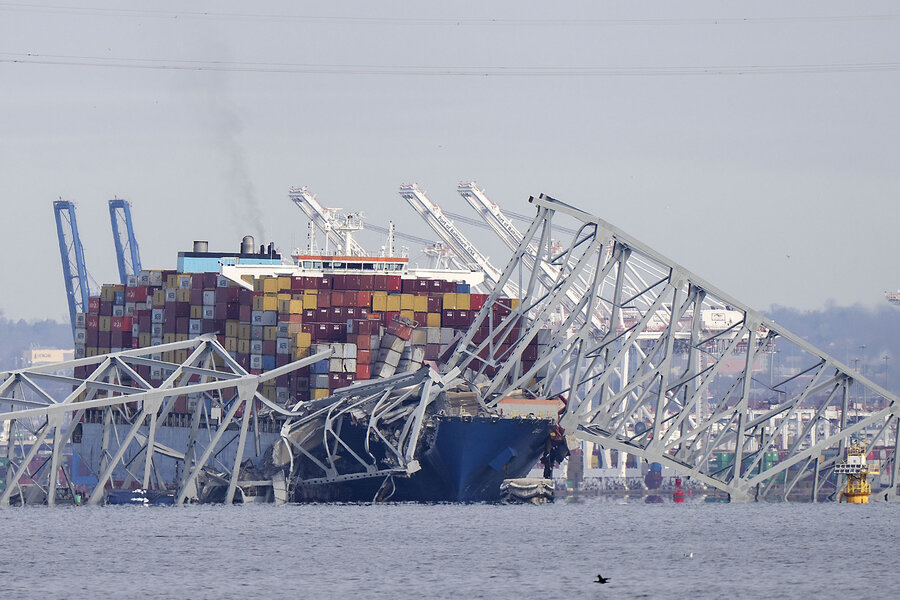Baltimore bridge collapse prompts focus on safety
| Baltimore
The collapse of the Francis Scott Key Bridge in Maryland on Tuesday illustrates the ongoing need for vigilance over America’s bridges, which are vulnerable choke points in the nation’s transportation infrastructure.
As of Tuesday afternoon, emergency workers were searching for several people still unaccounted for after a container ship collided with a pillar supporting part of the Baltimore bridge over the Patapsco River, sending several cars into the water.
On any given day, 49 bridges get hit, on average, often by trucks that are too tall for the structures that they’re trying to cross under. Collisions involving ships or barges are far rarer but can have more far-reaching implications. Fortunately, that particular risk is slowly on the decline.
After a freighter hit the Sunshine Skyway Bridge in Tampa Bay, Florida, in 1980, causing a collapse that was tied to 35 fatalities, safety engineers became far more focused on protecting the structures above navigable waters. A decade later, the American Association of State Highway and Transportation Officials issued more stringent bridge specifications designed to mitigate such disasters.
“Things are getting better,” says Mohamed ElGawady, a professor at the Center for Intelligent Infrastructure at Missouri University of Science and Technology. “It’s not as rapid as we wish, but in general, it’s moving forward.”
Unfortunately, the Key Bridge, hit by the cargo ship Dali in the early morning hours Tuesday, was built in the 1970s, before the new standards took effect.
Officials said that the operators of the Dali cargo ship had issued a mayday call that the vessel had lost power moments before the crash, but the ship still headed toward the span at “a very, very rapid speed,” Maryland Gov. Wes Moore told reporters.
Because of the mayday call, local officials were able to close the bridge just before it collapsed, likely saving lives. Two people were rescued, but officials said six people were still unaccounted for as of late morning. One body was found and pulled from the waters.
As of Tuesday afternoon, traces of the collapsed portions of the bridge could be seen in the 50-foot waters of the Patapsco River.
While commuters pulled their cars close to the harbor’s edge to catch a glimpse of the collapsed bridge, rescue workers continued diving into the frigid waters and helicopters circled above looking for survivors.
“This is no ordinary bridge,” said Secretary of Transportation Pete Buttigieg during remarks at a Tuesday afternoon press conference at Key Bridge. “This is one of the cathedrals of American infrastructure. It has been part of the skyline of this region for longer than many of us have been alive. So the path to normalcy will not be easy. It will not be quick. It will not be inexpensive. But we will rebuild together.”
The port is a big economic driver for Maryland, supporting 139,000 port-related jobs. It has become more important as a shipping destination since the 2016 expansion of the Panama Canal. That expansion allows larger ships to pass through Baltimore and other East Coast ports.
The accident is likely to tie up both highway traffic east of Baltimore and cargo traffic in and out of the city’s port. It’s a major entry point for imported cars and light trucks.
The collapse also highlights the ongoing needs of the nation’s more than 600,000 bridges. Of those, 1 in 3 are in need of replacement or repair. In 2021, in its latest assessment of the situation, the American Society of Civil Engineers gave bridges a C grade. That was actually a slight downgrade from the group’s 2017 grade.
But Dr. ElGawady is optimistic as states take the lead in using federal funds to improve their roads and other infrastructure.
“Many of those [older] bridges are being retrofitted,” he says. “So that certainly helps.”
In the two years since it was passed, the Bipartisan Infrastructure Law has dispersed nearly $400 billion to all 50 states, the Biden administration reported in November, although some of the money is earmarked for green energy rather than for roads, bridges, and other traditional infrastructure.
Local residents, meanwhile, said they were stunned. One railroad worker, who commutes to his job by driving across the Key Bridge each day, said that his work has already been affected. “It’s going to be horrible,” he said. “A large portion of railroad business comes off of shipping containers.” He added, “Only time will tell” how long shipping and traffic will be impacted.
The Associated Press contributed to this report.





